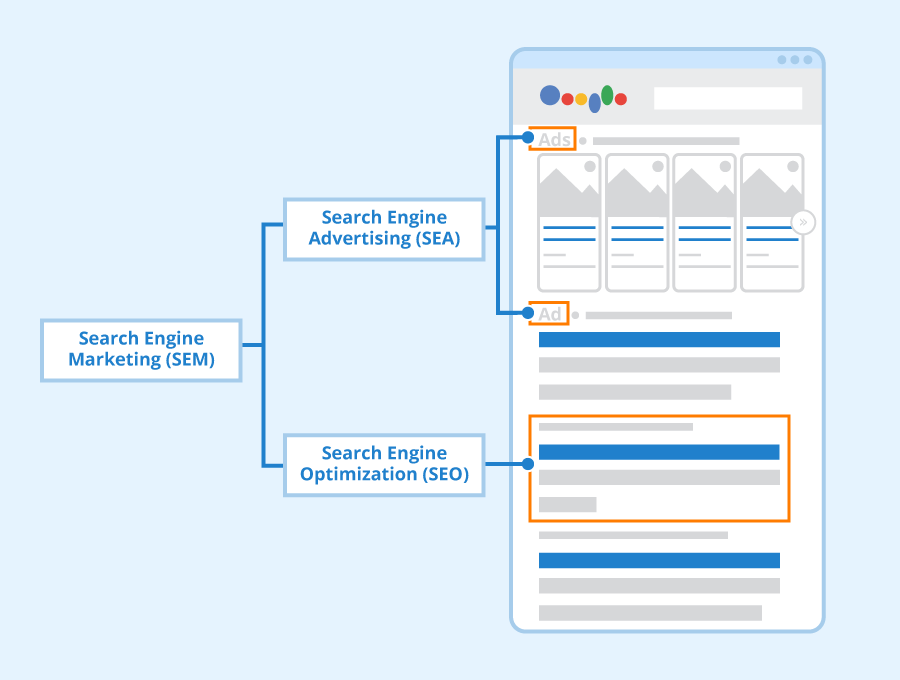Search engine optimization, or SEO, focuses on sending relevant visitors from search engines like Google to your website. User experience, or UX, is all about giving users a seamless, enjoyable experience once they arrive at your website.
Although UX and SEO are two distinct fields, they are not completely separate. Understanding how UX and SEO work together is crucial because UX can impact SEO in a significant way.
Why Does UX Matter?
UX or user experience describes the quality of an individual’s experience with a product or service. Good user experiences are those that help you complete your tasks and goals quickly, with little difficulty or confusion, and UX designers are trying their best to design it this way.
Think about the process of purchasing movie tickets. You could enter the name of your neighborhood movie theater into Google to find its website, click it, and then use the search bar to see what movies are playing there. When you locate a movie you want to see, you proceed to the checkout to buy your tickets. You get your tickets via email once your purchase is complete. The user experience is comprised of all the various steps in that process.
You’ll have a positive user experience if the process is quick, clear, and simple to follow, with a logical path from point A to point B. You’ll have a poor user experience if it’s riddled with mistakes, missing data, slow load times, or unnecessarily difficult obstacles.
Why Is UX Important?
The importance of UX cannot be overstated. The distinction between a successful and failed product can ultimately be determined by the quality of the user experience.
Here are some things you need to think about: 66% of customers are willing to pay more for a great user experience, and businesses that improve the UX design of their websites can see conversion rates rise by as much as 400%.
In the end, happy customers who continue to favor a specific brand over its rivals are the result of positive user experiences. These satisfied, devoted clients generate income and sustain the brand. User experience must be a top (if not the top) priority because a product or service is only as good as the experience it offers.
That sums up user experience. What about SEO?
Why Does SEO Matter?
Search Engine Optimization or SEO is a marketing and technical discipline that aims to increase a website’s position in search results by bringing in organic (free) traffic.
Think about what happens when you do a Google search. When you enter a phrase into the search field, Google returns a list of websites that it considers to be pertinent to your inquiry. In addition, it ranks them according to quality and relevance, placing the best outcomes at the top.
You might notice a few results at the very top that have the word “Ad” next to them. The position on those websites was purchased. However, the results below them have ranked naturally—rather than as a result of direct payment, but rather as a result of their search engine optimization efforts.

Why Is SEO Important?
SEO is important because it makes your website and content visible to the right audiences.
While other marketing strategies require you to reach out to potential customers, SEO draws them to you. Your chances of showing up on the first page of search results increase with how well your website is optimized for search engines. Because they actively searched for what you’re offering on Google, the people who then click on your website are already interested in what you’re offering.
When someone visits your website and likes what they see, they are more likely to come back, share your content, and perhaps even make a purchase. So, if you want to develop your brand and turn readers and visitors into customers, SEO is essential.
Now, let’s think about how UX and SEO work together and why it matters.
How Does SEO and UX Affect Each Other?
Creating a user-friendly website that provide users with the information they seek is the common goal of both SEO and UX.
Search engine algorithms take into account more than just technical factors when determining the credibility of a website. They also observe user behavior on the website to gauge the quality of the user experience it offers. A website will fall out of favor very quickly if the algorithms discover that users tend to leave a given website shortly after arriving there. It will drop in the rankings to make room for rivals who seem to be offering a better user experience.
Consider how frequently you’ve performed a Google search, clicked on the first or second result, and then realized moments later that the information was actually unrelated. Or perhaps the information is pertinent, but the constant barrage of pop-up advertisements that clutter your screen is off-putting. What about those occasions when you use your phone to access a website and discover that the design is haphazard or that the page won’t even load?
You will click the “back” button in each of these situations faster than you can say “bad UX.” Additionally, each of these situations is detrimental to the website’s SEO ranking.
Keep visitors on your website if you want to maintain a high ranking in the search results. Additionally, you must offer a positive user experience if you want visitors to stay on your website.
In light of this, the following are some of the key UX elements that will affect a website’s position in search engine results.
UX Factors That Impact SEO
There are elements that guarantee a positive user experience which also favorably affects the SEO of your website. If you want your website to succeed in both UX and SEO, pay close attention to the following five design elements.
Page Loading Speed
The user experience is terrible and SEO suffers on websites that take forever to load. You don’t need to be an expert in user experience to understand that slow-loading pages are incredibly annoying from a user perspective. Page speed is a proven ranking factor for Google.
So, what can you do to make your website load faster? You can stick to best practices. Some of them are design-related, such as lazy loading, a design strategy that only renders certain objects when they are absolutely necessary (for instance, only loading below-the-fold images as soon as the user begins to scroll). Others, like image optimization and CSS, JavaScript, and HTML code minification, are more technical and may call for a developer’s assistance.
Responsive Design
Regardless of the device they use to access your website, people expect a seamless experience. Although responsive design is not confirmed as a ranking factor, it is overtly endorsed by Google. Of course, this ensures a positive and consistent user experience across all devices.
When building and optimizing your website, responsive design should be a top priority because more than 60% of website traffic comes from mobile devices.
Website Copy
When it directs visitors to your website, Google wants to know that they can find the information they are looking for. It will examine a variety of factors, including how long they stay on your website (or how quickly they leave). Copy is a key component of the user experience that can affect how long a user stays on your site and, in turn, your website’s SEO.
Copy is one of the most effective tools for directing website visitors to the information they need and guiding them through your website. Website copy directs users in the right direction without making them look too far or think too hard, much like the road signs that direct drivers.
Users will find what they’re looking for more quickly and stay on your site longer if your website copy is strong. That’s a huge victory for SEO.
Layout and Navigation

Similar to this, the overall navigation and layout of your website should be created in a way that makes it as simple as possible for the user to get around.
Your website’s structure serves two purposes. On the UX side, it should give users an easy path to follow as they navigate your site. In terms of SEO, it offers a guide for search engines, outlining all the content on your site and how it is connected.
Prioritize the user when designing the structure and navigation of websites. Create pathways that are simple to follow and clear to navigate by erring on the side of simplicity and clarity. The design of individual pages follows the same rules. Utilize menus, headers, and CTAs to logically and visibly arrange your content.
If users can easily navigate your website, you’re doing more than just checking the usability box because it will also help boost your SEO too.
UI Design
Last but not least, make sure that the UI design of your website is optimized to leave a good first impression.
Google doesn’t evaluate a website’s visual appeal, of course, but human users do, and they do it quickly. Many visitors won’t stay to see what’s hidden if your website is an abomination to behold. They’ll click away in search of a website with better visual appeal. This translates to a high bounce rate for Google, which will unavoidably have an impact on your ranking.
Designing a user interface (UI) for a website entails more than just making sure it looks good. All of the UI’s guiding principles and rules are intended to facilitate the user journey that the UX designer has mapped out while delivering a consistent brand experience. In spite of the fact that UX and UI are two distinct concepts, they work very well together and cannot exist separately.
In Conclusion
Google takes into account a variety of factors when assessing and rating your website. It also considers user behavior, gathering information on how long visitors typically stay on your website and how they engage with it.
These user-related metrics are a reliable predictor of your website’s quality for Google, which in turn determines where it should rank in the search results. It’s straightforward: improve user experience, and you’ll improve SEO both directly and indirectly.



